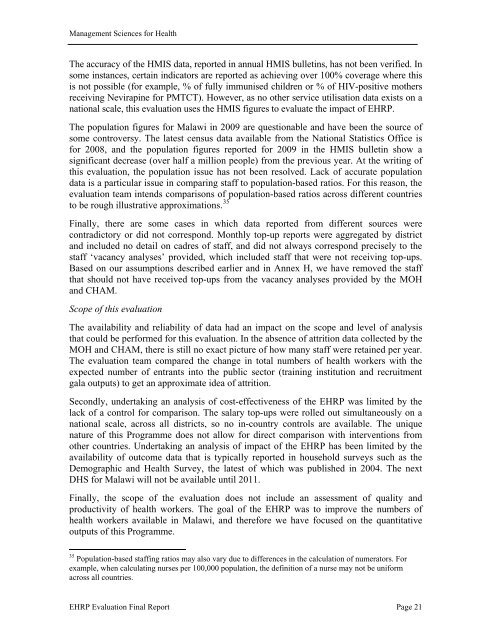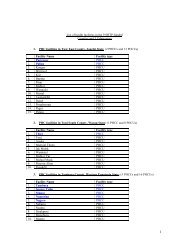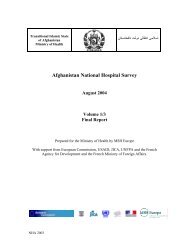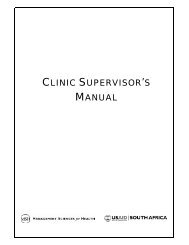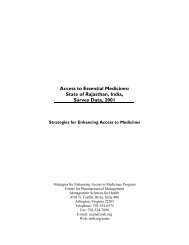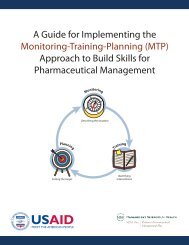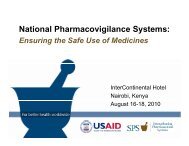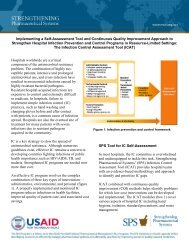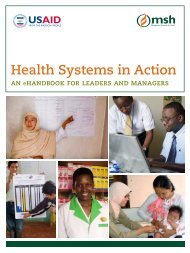Evaluation of Malawi's Emergency Human Resources Programme
Evaluation of Malawi's Emergency Human Resources Programme
Evaluation of Malawi's Emergency Human Resources Programme
Create successful ePaper yourself
Turn your PDF publications into a flip-book with our unique Google optimized e-Paper software.
Management Sciences for Health<br />
The accuracy <strong>of</strong> the HMIS data, reported in annual HMIS bulletins, has not been verified. In<br />
some instances, certain indicators are reported as achieving over 100% coverage where this<br />
is not possible (for example, % <strong>of</strong> fully immunised children or % <strong>of</strong> HIV-positive mothers<br />
receiving Nevirapine for PMTCT). However, as no other service utilisation data exists on a<br />
national scale, this evaluation uses the HMIS figures to evaluate the impact <strong>of</strong> EHRP.<br />
The population figures for Malawi in 2009 are questionable and have been the source <strong>of</strong><br />
some controversy. The latest census data available from the National Statistics Office is<br />
for 2008, and the population figures reported for 2009 in the HMIS bulletin show a<br />
significant decrease (over half a million people) from the previous year. At the writing <strong>of</strong><br />
this evaluation, the population issue has not been resolved. Lack <strong>of</strong> accurate population<br />
data is a particular issue in comparing staff to population-based ratios. For this reason, the<br />
evaluation team intends comparisons <strong>of</strong> population-based ratios across different countries<br />
to be rough illustrative approximations. 35<br />
Finally, there are some cases in which data reported from different sources were<br />
contradictory or did not correspond. Monthly top-up reports were aggregated by district<br />
and included no detail on cadres <strong>of</strong> staff, and did not always correspond precisely to the<br />
staff ‘vacancy analyses’ provided, which included staff that were not receiving top-ups.<br />
Based on our assumptions described earlier and in Annex H, we have removed the staff<br />
that should not have received top-ups from the vacancy analyses provided by the MOH<br />
and CHAM.<br />
Scope <strong>of</strong> this evaluation<br />
The availability and reliability <strong>of</strong> data had an impact on the scope and level <strong>of</strong> analysis<br />
that could be performed for this evaluation. In the absence <strong>of</strong> attrition data collected by the<br />
MOH and CHAM, there is still no exact picture <strong>of</strong> how many staff were retained per year.<br />
The evaluation team compared the change in total numbers <strong>of</strong> health workers with the<br />
expected number <strong>of</strong> entrants into the public sector (training institution and recruitment<br />
gala outputs) to get an approximate idea <strong>of</strong> attrition.<br />
Secondly, undertaking an analysis <strong>of</strong> cost-effectiveness <strong>of</strong> the EHRP was limited by the<br />
lack <strong>of</strong> a control for comparison. The salary top-ups were rolled out simultaneously on a<br />
national scale, across all districts, so no in-country controls are available. The unique<br />
nature <strong>of</strong> this <strong>Programme</strong> does not allow for direct comparison with interventions from<br />
other countries. Undertaking an analysis <strong>of</strong> impact <strong>of</strong> the EHRP has been limited by the<br />
availability <strong>of</strong> outcome data that is typically reported in household surveys such as the<br />
Demographic and Health Survey, the latest <strong>of</strong> which was published in 2004. The next<br />
DHS for Malawi will not be available until 2011.<br />
Finally, the scope <strong>of</strong> the evaluation does not include an assessment <strong>of</strong> quality and<br />
productivity <strong>of</strong> health workers. The goal <strong>of</strong> the EHRP was to improve the numbers <strong>of</strong><br />
health workers available in Malawi, and therefore we have focused on the quantitative<br />
outputs <strong>of</strong> this <strong>Programme</strong>.<br />
35 Population-based staffing ratios may also vary due to differences in the calculation <strong>of</strong> numerators. For<br />
example, when calculating nurses per 100,000 population, the definition <strong>of</strong> a nurse may not be uniform<br />
across all countries.<br />
EHRP <strong>Evaluation</strong> Final Report Page 21


